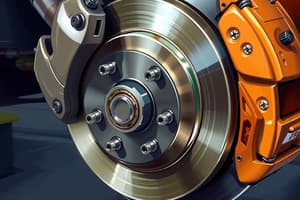Podcast
Questions and Answers
What is a significant factor that makes semi-metallic linings require more brake pedal effort than organic linings?
What is a significant factor that makes semi-metallic linings require more brake pedal effort than organic linings?
- Lower operating temperatures
- Increased weight
- Increased material hardness (correct)
- Higher coefficient of friction
Which of the following statements correctly identifies a disadvantage of semi-metallic linings compared to organic linings?
Which of the following statements correctly identifies a disadvantage of semi-metallic linings compared to organic linings?
- Lower thermal stability
- Higher noise levels during operation (correct)
- Ineffective under high loads
- Reduced fade resistance
What material has seen a decrease in usage within brake linings due to environmental concerns?
What material has seen a decrease in usage within brake linings due to environmental concerns?
- Copper (correct)
- Aluminium
- Zinc
- Lead
Which characteristic of semi-metallic linings impacts their effectiveness at low temperatures?
Which characteristic of semi-metallic linings impacts their effectiveness at low temperatures?
What are the two common types of synthetic materials used as brake linings?
What are the two common types of synthetic materials used as brake linings?
Which material was commonly used for brake linings for many decades before being replaced due to health concerns?
Which material was commonly used for brake linings for many decades before being replaced due to health concerns?
What is a characteristic of non-asbestos organic (NAO) linings compared to metallic linings?
What is a characteristic of non-asbestos organic (NAO) linings compared to metallic linings?
What are the primary components of today's organic brake linings?
What are the primary components of today's organic brake linings?
What is a notable disadvantage of high-temperature organic linings compared to standard organic linings?
What is a notable disadvantage of high-temperature organic linings compared to standard organic linings?
What is one of the main reasons manufacturers have phased out asbestos in brake components?
What is one of the main reasons manufacturers have phased out asbestos in brake components?
Flashcards are hidden until you start studying
Study Notes
Brake Linings Overview
- Brake linings are materials used on brake pads and shoes, attached either by riveting or bonding.
- Newer designs include integrally moulded pads, identifiable by lining-filled backing holes.
- Historically, asbestos was the primary material due to its good friction qualities, long wear, and low noise.
Regulations and Material Shift
- Health concerns led to global bans on asbestos for new vehicles and aftermarket parts.
- North American bans faced legal challenges and some repealed, yet manufacturers moved away from asbestos for liability reasons.
Non-Asbestos Organic (NAO) Linings
- NAO linings, widely used by OEMs, are composed of non-metallic fibers formed into a composite.
- Key components of NAO linings include:
- Friction materials like graphite and powdered metals.
- Fillers for noise reduction and heat transfer.
- Binders for material cohesion.
- Curing agents to enhance binding properties.
- Features: High coefficient of friction (COF), economical, quiet, slow wear, mild rotor abrasion.
- Limitations include quick fading and inefficiency at high temperatures.
Metallic Linings
- Historically used in racing, made from powdered metals shaped by heat and pressure.
- Advantages include excellent brake fade resistance; however, they require higher pedal pressure and lead to significant rotor wear.
- Ineffective until fully warmed up, and they produce considerable noise.
- Newer materials (high-temperature organic, semi-metallic) have diminished their use in modern vehicles.
Semi-Metallic Linings
- Comprised of organic/synthetic fibers mixed with metals, primarily iron and steel fibers.
- Generally, 50% of the material includes metals, with some copper use, now reduced due to environmental concerns.
- Require warming to reach optimal efficiency, which can make them less effective at low temperatures.
- Historically used in older vehicles with four-wheel drum brakes, less efficient on FWD cars’ rear brakes due to lighter loads.
- Have a lower static COF than organic linings, impacting parking brake efficiency.
Synthetic Linings
- Development aimed at overcoming the limitations of existing materials for improved braking performance.
- Classified as synthetic due to the absence of organic, metallic, or asbestos materials.
- Common synthetic materials used in drum brakes include fibreglass and aramid fibers.
Studying That Suits You
Use AI to generate personalized quizzes and flashcards to suit your learning preferences.




